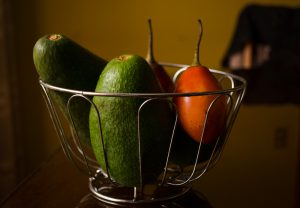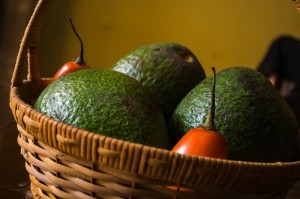Avocado Weirdness in Peru

An oddity of Peru. It has lots of indigenous varieties of avocados. Through out its hot lands avocados have been grown for millennia. There are probably hundreds of varieties. and wild avocados are found nearby. Yet its super markets and, increasingly, local markets are filled with a single variety, fuerte, which is not a Peruvian avocado.
Though when the Spanish came, they found avocados in Peru, nevertheless the fuerte is a hybrid avocado from Mexico by way of California. It came sometime in the twentieth century and became the darling of commercial production although Peru is now an important grower of Hass avocados, another hybrid, for export. You seldom see them here. The fuerte´s dominance of markets shows the power of industrial agriculture in Peru.
Recently I was in Quebrada Honda, the capital of Yanatile District in Calca, Cusco. It is a region known for coca, fruit and, increasingly, coffee. Its farmers are small scale, family farmers.
While I was there, they held a fair in the sports complex in honor of the anniversary of the town. I walked up and down the aisles of fruit, coffee, and other products, including avocados. I did not see a single fuerte, much less a hass.
The avocados were large and round. I bought some called Mexico. The name surprised me and I asked if the variety was from Mexico. No, the man attending the stand said. It was just a name they adopted for the purposes of commerce.

I have never seen that avocado here in the markets of Cuzco, even though Yanatile is part of Cuzco and its roads lead here, to the capital.

However, my question was not a random one. Even remote, rural farmers seek new varieties in order to gain a better foot hold in the market. Seeds and plants travel from region to region along with them when they make visits, some of the organized by the Peruvian government.
Furthermore, agricultural extension agents are found throughout Peru and seek to improve the commercial possibilities of small-scale rural agriculture, what used to be called campesino farming.
It is entirely possible that varieties new to the region have come through either channel and are being adopted, even as older, more traditional varieties (such as those described by the Chronicler Garcilaso de la Vega for the 16th century) are declining, if not disappearing.
Later I sat under a rustic roof on a farmstead high up one of the slopes while conversing with the farmers and two agricultural technicians. Among other things I asked them why so few varieties are found in urban markets.
Their answer was simple and direct. It is a problem of transport. The intermediary merchants only want to buy products that ship well in trucks up over very difficult and bumpy roads that climb to a very high pass before dropping into the Sacred Valley of the Incas and then making their way to the city of Cuzco.
Farmers have to make decisions about the varieties they cultivate and which markets they cultivate them for. What they raise and eat for themselves is often very different than what they send to regional urban markets, like those of the city of Cuzco.

Furthermore, it is very difficult for small-scale family farms to compete with the industrial farms of the Peruvian coast and Peru´s desert valleys. They lack competitive size, access to capital, and ease of transport to major markets.
Nonetheless, remote rural areas such as Quebrada Honda or Santo Domingo, where I had the conversation with the family and technicians, still are centers of variety and a whole range of tastes and forms.
Some of the better restaurants in Cuzco attempt to rely on unique, small farm produce, in a farm to market style operation, but increasingly the amazing variety of rural Peru, with its incredible tastes and textures cannot be found in the city’s markets, nor is it found in the fields most directed to merchants who supply large markets.
I find this sad. I wish I could reintroduce my friends in urban Peru to the glories of their own avocados and get them to leave the fuerte to the gringos, but the market rules in its imperial glory.




